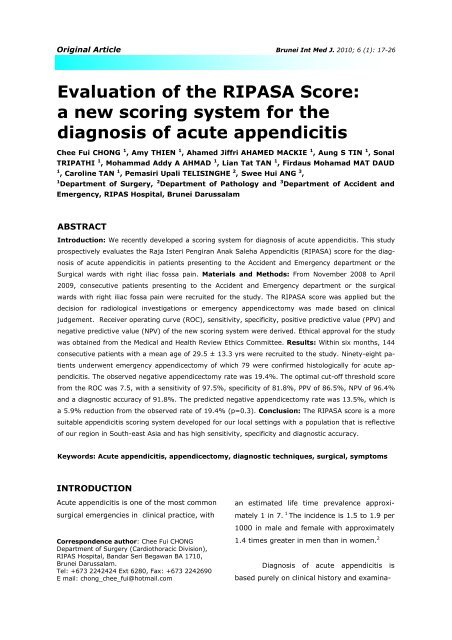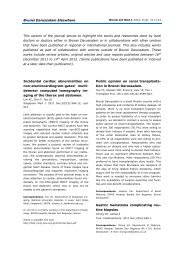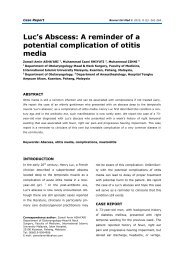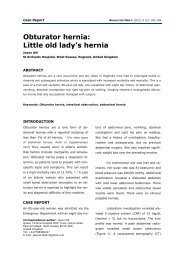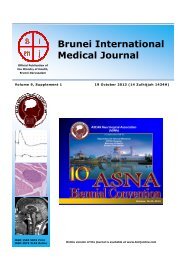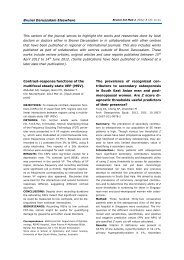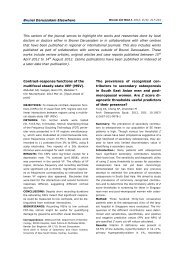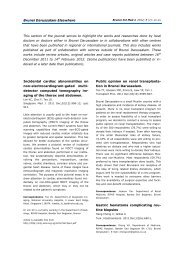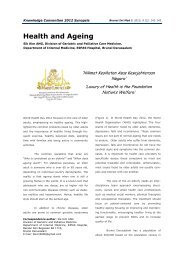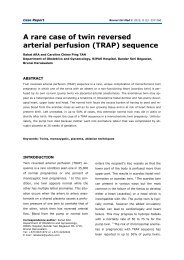Final BIMJ Volume 6 Issue 1.pub - Brunei International Medical ...
Final BIMJ Volume 6 Issue 1.pub - Brunei International Medical ...
Final BIMJ Volume 6 Issue 1.pub - Brunei International Medical ...
Create successful ePaper yourself
Turn your PDF publications into a flip-book with our unique Google optimized e-Paper software.
Original Article <strong>Brunei</strong> Int Med J. 2010; 6 (1): 17-26Evaluation of the RIPASA Score:a new scoring system for thediagnosis of acute appendicitisChee Fui CHONG 1 , Amy THIEN 1 , Ahamed Jiffri AHAMED MACKIE 1 , Aung S TIN 1 , SonalTRIPATHI 1 , Mohammad Addy A AHMAD 1 , Lian Tat TAN 1 , Firdaus Mohamad MAT DAUD1 , Caroline TAN 1 , Pemasiri Upali TELISINGHE 2 , Swee Hui ANG 3 ,1 Department of Surgery, 2 Department of Pathology and 3 Department of Accident andEmergency, RIPAS Hospital, <strong>Brunei</strong> DarussalamABSTRACTIntroduction: We recently developed a scoring system for diagnosis of acute appendicitis. This studyprospectively evaluates the Raja Isteri Pengiran Anak Saleha Appendicitis (RIPASA) score for the diagnosisof acute appendicitis in patients presenting to the Accident and Emergency department or theSurgical wards with right iliac fossa pain. Materials and Methods: From November 2008 to April2009, consecutive patients presenting to the Accident and Emergency department or the surgicalwards with right iliac fossa pain were recruited for the study. The RIPASA score was applied but thedecision for radiological investigations or emergency appendicectomy was made based on clinicaljudgement. Receiver operating curve (ROC), sensitivity, specificity, positive predictive value (PPV) andnegative predictive value (NPV) of the new scoring system were derived. Ethical approval for the studywas obtained from the <strong>Medical</strong> and Health Review Ethics Committee. Results: Within six months, 144consecutive patients with a mean age of 29.5 ± 13.3 yrs were recruited to the study. Ninety-eight patientsunderwent emergency appendicectomy of which 79 were confirmed histologically for acute appendicitis.The observed negative appendicectomy rate was 19.4%. The optimal cut-off threshold scorefrom the ROC was 7.5, with a sensitivity of 97.5%, specificity of 81.8%, PPV of 86.5%, NPV of 96.4%and a diagnostic accuracy of 91.8%. The predicted negative appendicectomy rate was 13.5%, which isa 5.9% reduction from the observed rate of 19.4% (p=0.3). Conclusion: The RIPASA score is a moresuitable appendicitis scoring system developed for our local settings with a population that is reflectiveof our region in South-east Asia and has high sensitivity, specificity and diagnostic accuracy.Keywords: Acute appendicitis, appendicectomy, diagnostic techniques, surgical, symptomsINTRODUCTIONAcute appendicitis is one of the most commonsurgical emergencies in clinical practice, withCorrespondence author: Chee Fui CHONGDepartment of Surgery (Cardiothoracic Division),RIPAS Hospital, Bandar Seri Begawan BA 1710,<strong>Brunei</strong> Darussalam.Tel: +673 2242424 Ext 6280, Fax: +673 2242690E mail: chong_chee_fui@hotmail.coman estimated life time prevalence approximately1 in 7. 1 The incidence is 1.5 to 1.9 per1000 in male and female with approximately1.4 times greater in men than in women. 2Diagnosis of acute appendicitis isbased purely on clinical history and examina-
CHONG et al. <strong>Brunei</strong> Int Med J. 2010; 6 (1): 18tion combined with a few laboratory investigationssuch as elevated white cell count.Despite being a common problem, acute appendicitisremains a difficult diagnosis to establishin some cases, particularly in theyoung, elderly and female patients of reproductiveage where a host of other genitourinaryand gynaecological inflammatory conditionscan also present with similar signs andsymptoms of acute appendicitis. 3 Severalscoring systems have been developed to aidin the decision making process of deriving adiagnosis of acute appendicitis in the fastestand cheapest way. The ‘Alvarado score’ andthe ‘Modified Alvarado score’ are the twomost commonly used scoring system available.4,5 Reported sensitivity and specificity forboth Alvarado and the Modified Alvaradoscores ranges from 53 to 88% and 75 to 80%respectively. 4,5 However, these scoring systemswere developed in western countriesand several studies have reported very lowsensitivity and specificity when applied to apopulation with a completely different ethnicorigin and diet. 6-8The Raja Isteri Pengiran Anak SalehaAppendicitis (RIPASA) score is a simple qualitativescoring system based on 14 fixed clinicalparameters (two demographics, five clinicalsymptoms, five clinical signs and two clinicalinvestigations) and one additional parameter(foreign national Identity card) asshown in the Appendix. We recently reportedour retrospective analysis of the RIPASAscore which showed a sensitivity and specificityof 88% and 67% respectively with a diagnosticaccuracy of 81%. 9 In this study, wereport on the prospective evaluation of theRIPASA score in patients presenting with rightiliac fossa (RIF) pain.MATERIALS AND METHODSPatients: 144 consecutive patients presentingto the Accident and Emergency department(AED) or the Department of Surgery atRaja Isteri Anak Saleha (RIPAS) Hospital fromNovember 2008 to April 2009, with RIF painwere recruited for the study. All patients of allage groups presenting with RIF pain, suspectedto be acute appendicitis were includedin this study. Patients presenting with non-RIFpain and those who have been admitted byother specialties for other complains but whosubsequently developed RIF pain were excludedfrom the study. Ethical approval toconduct the study was granted by the <strong>Medical</strong>and Health Review Ethics Committee (MHREC)at RIPAS Hospital.Scoring of RIPASA score sheet: Prospectiveevaluation of the RIPASA score was doneby the completion of the score sheet(Appendix). The score sheet does not containedthe actual scores for each parameter inorder to avoid the total score biasing thejudgement of the admitting surgeon in his/herdecision making with respect to appendicectomy,which was still solely based on the surgeon’sown clinical judgement for this prospectiveevaluation study.Initial scoring was performed by anAED senior medical officer (SMO) if the patientis seen in the AED. Scoring thereafterwill be carried out by the admitting surgeonwhen the patient is admitted to the surgicalward or if the patient has been referreddirectly to the admitting surgical team by thegeneral practitioner. Only scores derived by asurgeon of senior grade (Post membershipSMO or equivalent registrar or consultant) willbe considered.
CHONG et al. <strong>Brunei</strong> Int Med J. 2010; 6 (1): 19Scoring was performed at every review;either two hourly or at the next morningward round if the patient’s was admittedin the early hours of the morning, until adecision was made for either appendicectomyor continued conservative observation/treatment.Completed forms were collected by theward clerk and kept in a folder specifically forthe study. There were later collected by thestudy coordinator at regular intervals.Data regarding patients’ admissionand discharge dates, date of appendicectomyif performed, name and signature of confirmingsurgeon, post-operative complicationsand use of radiological investigations wererecorded in the score sheet. All histologicalconfirmation of appendicular specimens obtainedfrom emergency appendicectomy werereviewed by a single senior pathologist atDepartment of Pathology, RIPAS hospital.Statistical Analysis: Receiver operatingcurve (ROC) at the optimal cut-off thresholdscore for the RIPASA score was derived usingStatsDirect statistical software version 2.7.2(StatsDirect Ltd, Cheshire, UK 2008). Sensitivity,specificity, positive predictive value(PPV), negative predictive value (NPV) anddiagnostic accuracy at the optimal cut-offthreshold score were also derived from theROC. Predicted negative appendicectomyrates for the RIPASA score was also derivedand compared with the observed negativeappendicectomy rate using the Chi-squaretest for statistical analysis.RESULTSDemographic and operative details for the144 study patients are shown in Table 1. Themean age of the group was 29.5 ± 13.3 yearswith slightly more female (male:female ratio,1:1.3).Patients who were treated conservativelyand subsequently discharged were reviewedonce in the surgical out-patient clinica week after discharge. Patients who weredischarged from the AED were reviewed atthe AED clinic. All patients with true negativeRIPASA score status were later contacted viatelephone within a month to confirm theirtrue negative RIPASA score status and thatthey have not been readmitted and have undergoneemergency appendicectomy either atRIPAS or at another hospital at a later date.As all pathological specimens weresent to the Department of Pathology at RIPAShospital, confirmation of true negatives werefurther collaborated by cross referencing withthe patient’s name to specimens at the Departmentof Pathology services.Ultrasound investigations were performedin only 25.7% of all patients with majority(81.8%) performed in female patients(Table 1) and 62.2% were in patients withscore
CHONG et al. <strong>Brunei</strong> Int Med J. 2010; 6 (1): 20month after the episode.patients, indicating a negative appendicectomyrate of 19.4%. The mean duration ofhospital stay was 4.4 ± 1.9 (1 to 16) days.Post-operative complications rate was 4.1%(Table 1). All 144 patients were dischargedalive.RIPASA scoreTable 2 showed the distribution of the 144patients in 4 groups, according to the RIPASAscore at cut-off threshold score of 7.5. Of the79 positive cases of acute appendicitis, 77were in patients with RIPASA scores >7.5(true positive). Only two cases with positiveappendicitis had RIPASA score 7.5 (false positive) andseven were in patients with RIPASA score
CHONG et al. <strong>Brunei</strong> Int Med J. 2010; 6 (1): 21Table 2: Distribution of patients according to RIPASA scores with cut-off threshold at 7.5.RIPASA scorePTrue +ve False –ve True –ve False –ve>7.5 >7.5
CHONG et al. <strong>Brunei</strong> Int Med J. 2010; 6 (1): 22a1st score (100%) 2nd score (45.5%) 3rd score (11.7%) 4th scoreb1st score 2nd score 3rd score 4th score 5th score 6th score(100%) (92.6%) (74.1%) (25.9%) (16.7%) (5.6%)Figure 2: (a) Chart showing a horizontal trend of total RIPASA score which remains above 7.5, despite repeatedscoring, in the true positive group of patients with confirmed acute appendicitis (RIPASA score >7.5). (b) Chartshowing decreasing trend of total score with each repeated scoring, in the true negative group of patients(RIPASA score 7.5) and 81.5% of negative appendicitis tothe low probability group (score
CHONG et al. <strong>Brunei</strong> Int Med J. 2010; 6 (1): 23SensitivityRIPASA ScoreFigure 3: ROC plot for the RIPASA score.1-Specificityand the Modified Alvarado scores when appliedto a similar population. 6-8Recently, a new scoring system called‘Appendicitis inflammatory response score’was introduced by Andersson et al in 2008.This scoring system had a sensitivity of only96% and a specificity of 73% for a cut-offthreshold set at >4 or a sensitivity of 37%and specificity of 99% if the cut-off thresholdwas set at >8. 13 Using this Appendicitis inflammatoryresponse score, 73% of the nonappendicitispatients (true negative and falsepositive) were classified to the low probabilitygroup while 67% of patients with advancedappendicitis (true positive and false negative)were classified to the high probability groupwith a high accuracy, in comparison with 97%and 82% respectively for the RIPASA score.In the Appendicitis inflammatory responsescore, a significantly higher percentage(37%) of patients were in the indeterminategroup, in comparison with 9.7% for the RI-PASA score (p
CHONG et al. <strong>Brunei</strong> Int Med J. 2010; 6 (1): 24Table 3: Management guidelines for patients presenting with RIF pain suspected of acute.Total RIPASA ScoreManagement guidelines12 Definite acute appendicitis, refer to surgeon on-call for admission andappendicectomy. Keep nil by mouth. Start appropriate antibiotics based oninstitutional antibiotic guidelines.score between 7.5 and 12, it would be advisableto perform further investigations such asan abdominal ultrasound to exclude pelvicpathology, as 75% of patients in the falsepositive group were female.The RIPASA score is a simple andeasy to use quantitative scoring system andas shown in Appendix, most of these 14 clinicalparameters are easily obtained from agood clinical history and examination. Thisalso include a urinalysis which can be easilyperformed on the spot. Hence a score can beobtained quickly and a rapid diagnosis madewithout having to wait for the full investigationsto be available when a score of >7.5 isobtained. The additional parameter which isunique to our local population consists offoreign nationality. As previously explained,foreign nationals were included as an additionalparameter as the probability of acuteappendicitis among foreign nationals presentingwith RIF pain was 0.96 based on logisticregression analysis. 6,9Although the RIPASA score was specificallydeveloped for our local population,the 14 fixed clinical parameters are general toall populations and hence the RIPASA scorecan be applied in any country. The additionalparameter of foreign NRIC can be included tothe score in countries where there is a largeforeign work-force like our own who have topay for any healthcare treatment.In conclusions, the RIPASA score is asimple scoring system with high sensitivityand specificity for the diagnosis of acute appendicitis.The 14 clinical parameters are allpresent in a good clinical history and examinationand can be easily and quickly applied.Therefore, a decision on the management canbe made early. Although the RIPASA scorewas developed for our local population, webelieve that it should be applicable to all regions.
CHONG et al. <strong>Brunei</strong> Int Med J. 2010; 6 (1): 25ACKNOWLEDGEMENTSRIPASA scoring prospective evaluation studygroup consisted of the following:Department of Surgery: Chee Fui CHONG,Amy THIEN, Ahamed Jiffri Ahamed MACKIE,Aung S TIN, Sonal TRIPATHI, Mohammad AdyAdillah AHMAD, Lian Tat TAN, FirdausMohamad MAT DAUD and Caroline TAN.Department of Pathology: Pemasiri UpaliTELISINGHE.Department of Accident and Emergency:Swee Hui ANG.Special thanks to Kim Khee TAN, Kenneth YuhYen KOK, Varkey Vallikad MATHEW, Oo PAW,Hock Beng CHUA, Samuel Kai San YAPP, allfrom the Department of Surgery and staffs atWards 2 (Paediatric), 6, 7 (Surgical) and RI-PAS Hospital Accident and Emergency Departmentfor their help.REFERENCES1: Stephens PL, Mazzucco JJ. Comparison of ultrasoundand the Alvarado score for the diagnosis ofacute appendicitis. Conn Med 1999; 63:137-40.2: Cuscheri A, G R Giles, A R Mossa. (Editors), Thesmall intestine and vermiform appendix (1995) In:Essential surgical practice, Butter worth Heinman,London, p. 1325-8.3: Gilmore OJ, Browett JP, Griffin PH, et al. Appendicitisand mimicking conditions. A prospectivestudy. Lancet 1975; 2:421-4.4: Alvarado A. A practical score for the early diagnosisof acute appendicitis. Ann Emerg Med 1986;15:557-64.5: Kalan M, Talbot D, Cunliffe WJ, et al. Evaluationof the modified Alvarado score in the diagnosis ofacute appendicitis: a prospective study. Ann R CollSurg Engl 1994; 76:418-9.6: Al-Hashemy AM, Seleem MI. Appraisal of themodified Alvarado Score for acute appendicitis inadults. Saudi Med J 2004; 25:1229-31.7: Khan I, ur Rehman A. Application of alvaradoscoring system in diagnosis of acute appendicitis. JAyub Med Coll Abbottabad 2005;17:41-4.8: Jang SO, Kim BS, Moon DJ. Application of alvaradoscore in patients with suspected appendicitis.Korean J Gastroenterol 2008; 52:27-319: Chong CF, Adi MIW, Thien A, et al. Developmentof the RIPASA score, a new appendicitis scoringsystem for the diagnosis of acute appendicitis. SingaporeMed J 2010; 51: 220-5.10: Kumar V, Cotran RS, Robbins SL, Appendix(1992) In: Robbin's Basic Pathology, W.B Saunders,London, p. 520.11: Pal KM, Khan A. Appendicitis, a continuing challenge.J Pak Med Assoc 1998; 48:189-9212: Terasawa T, Blackmore CC, Bent S, et al. Systematicreview: computed tomography and ultrasonographyto detect acute appendicitis in adultsand adolescents. Ann Intern Med 2004; 141:537-46.13: Andersson M, Andersson RE. The appendicitisinflammatory response score: a tool for the diagnosisof acute appendicitis that outperforms the Alvaradoscore. World J Surg 2008; 32:1843-9.14: Livingston EH, Woodward WA, Sarosi GA, et al.Disconnect between incidence of nonperforated andperforated appendicitis: implications for pathophysiologyand management. Ann Surg 2007; 245:886-92.
APPENDIXCHONG et al. <strong>Brunei</strong> Int Med J. 2010; 6 (1): 26RIPAS APPENDICITIS (RIPASA) SCOREPATIENT’S NAME:_____________________________________________________ AGE: __________NRIC NO:_________________________Hospital Record No:________________________Date of AssessmentTime of AssessmentScore Score Score Score Score Score ScorePatient’s DemographicFemale 0.5Male 1.0Age < 39.9 yrs 1.0Age > 40 yrs 0.5SymptomsRIF pain 0.5Pain migration to RIF 0.5Anorexia 1.0Nausea & Vomiting 1.0Duration of symptoms 48 hrs 0.5SignsRIF tenderness 1.0Guarding 2.0Rebound tenderness 1.0Rovsing’s Sign 2.0Fever >37ºC,


